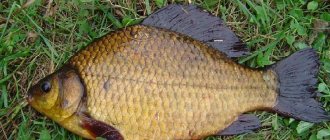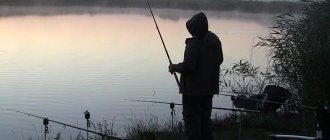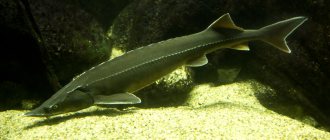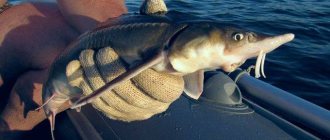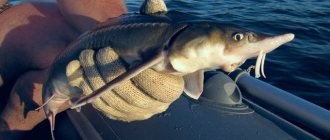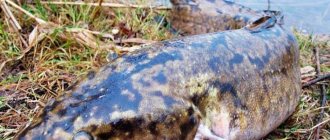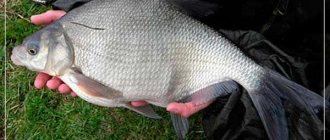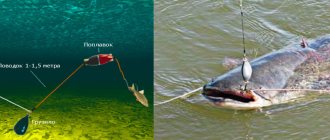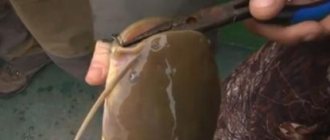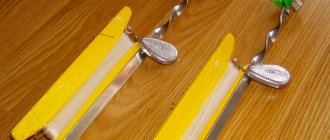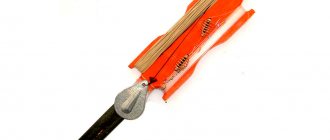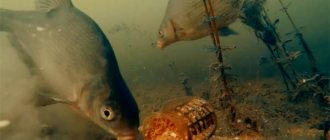Sterlet is a coveted trophy for all fishermen. This sturgeon fish has long been famous for its gastronomic properties, and its fishing is revered by many fishing enthusiasts. It is not easy to catch this representative of the ichthyofauna today, since its population is extremely depleted, and in some reservoirs where it was found before, now you will not find a single individual.
None Important!
Under a license, sterlet can be caught in a certain quantity using nets of specified sizes or bottom gear of no more than five pieces with five hooks on each.
Types of bottom gear are described in detail here. Since the only method of amateur hunting for sterlet permitted by the license is donka, then further discussion will be about this gear.
Bottom tackle device
Gear for catching sterlet is not particularly original. It can be assembled from simple accessible elements, so the fisherman does not have to spend money on expensive rods, lines and reels. All donkey components can be purchased at any fishing store.
A fishing rod for donkey for sterlet is chosen with a length of 2.40 to 3.50 meters. You can take a regular steel spinning rod or a modern feeder fishing rod with the necessary power reserve. With a “stick”, the angler should be able to make long casts and forcefully catch a hooked fish.
It is better to choose an inertial coil. It is reliable, and its simplicity guarantees the durability of the product. The disadvantage is the formation of beards and tangling of the line when casting. However, this only happens to beginners who have not yet properly mastered the correct technique for throwing the rig. They can be recommended to use the inertia-free system, which is devoid of such a disadvantage. An inexpensive, powerful model with decent traction parameters will do.
Photo 1. “Neva” coil - you can’t imagine it being more powerful!
When using a steel rod, it is advisable to wind a monofilament line onto the reel. Its disadvantage is the extensibility and, as a result, low sensitivity of the gear. It is better to fish with a feeder with a cord, since it is equipped with modern high-quality rings that will not wear out the braid.
The diameter of the fishing line is selected in the range of 0.30–0.35 mm. Due to its high strength, the cord can be taken thinner. It is advisable to use a fluorocarbon leash. The fact is that sterlet fishing is often carried out on a pebble bottom or strewn with shell rock, so abrasive resistance is of great importance for successful fishing. The thickness of the flurish branch should be slightly less than the main thread. Usually a length of 0.20–0.25 mm is tied. Its length ranges from 20–50 cm and depends on the mood of the fish.
The hook is of medium size. It is rational to select it according to the bait, and not according to the probable weight of the sterlet. As a rule, Nos. 8–6 are used, rarely larger ones. The best baits for this underwater representative are:
- earthworm or dungworm;
- maggot;
- live bait
Photo 2. Maggot is also good for sterlet! Maggot and worm can be combined by placing them on the hook at the same time.
To catch large specimens of sterlet, it makes sense to immediately pin a bunch of bait or a small fish up to 5 cm long. Its role is often played by a gudgeon, goby, ruff or perch.
For donkey fishing for sterlet, you need to use lead sinkers of a flat shape and decent weight, since its fishing is carried out on the current and hard ground. The casting equipment must lie stably on the bottom at a given fishing point.
[custom_ads_shortcode1]
Peculiarities of sterlet behavior
Sterlet is a sturgeon fish. This is a valuable commercial species, which is the object of industrial and recreational fishing. It lives for about 30 years, can reach a length of up to 1.25 meters and a weight of up to 16 kg. Fishermen's catches most often include specimens weighing 0.5–3 kg.
The male sterlet reaches sexual maturity in the fifth year of life, the female in the seventh or eighth. Spawns in May. To spawn, it climbs up the river bed, where it selects deep areas.
The eggs are sticky. The fish lays up to 140 thousand pieces, which attach to the rocky and pebble bottom.
The sterlet leads a secretive lifestyle. This fish always stays near the bottom in deep areas. She, like a vacuum cleaner, collects food, looking for it among the soil.
Therefore, it is not easy to detect. You need to know the reservoir well and the habits of this representative of the ichthyofauna.
In autumn, sterlet migrates to the deepest parts of the reservoir. As the water gets colder, it becomes passive and tries not to make unnecessary movements. The fish spends the entire winter in this state, so targeted fishing during this period is unproductive.
For reference!
In winter, sterlet gathers in numerous groups. It occupies deep holes, where it can stand at the bottom, literally, in layers on top of each other.
Sterlet becomes active with the beginning of the spring flood. When the water level rises, it can approach the coastal zone, occupying the coastal edges. It is impossible to guess its location in advance, but if the fisherman managed to throw the equipment at the point where the fish was located, then a bite will definitely follow.
Sterlet loves fast rivers with clean water saturated with oxygen. This fish avoids stagnant areas where there is no current. For her residence, she chooses deep holes and riverbed ditches.
The bottom should be a hard sandy structure with the presence of pebbles or shell rock. This underwater inhabitant cannot be found in muddy areas.
The best place for catching sterlet will be the exit from the hole. This is where you should throw the equipment. You can try to look for fish at the entrance to the depths, but here they appear less often. If there is a small submerged snag at the fishing point, then a bite will occur with almost one hundred percent probability.
So, the typical places where fishing for sterlet shows maximum results are: At night, sterlet can go to shallow water areas. Here she collects various food from the bottom and swarms in the soil. It makes no sense to purposefully hunt for it at night, since in this regard the fish is not constant.
Donka fishing for sterlet begins in March and can continue until late November, until the reservoirs are covered with ice. The best periods for fishing are:
We must not forget that this underwater inhabitant is a schooling fish. If you managed to catch one specimen at the fishing point, then the probability of catching the next one is very high and, in the absence of bites, you should not rush to change the fishing location. Sterlet feeds on exits, like many other species of ichthyofauna, so you need to wait for a surge in its activity.
It is better to catch sterlet using several donks at the same time. Experienced fishermen install two or three rods. If fishing is carried out in a long hole, then it is advisable to place donks at the entrance and exit, as well as in the middle.
If a snag is found at the bottom, then the equipment must be thrown closer to the shelter. There is a high probability of fish biting there.
The best sterlet bite is observed in the morning. In summer, it is active at night, but in many regions catching it at this time of day is prohibited. During the day and evening, the fish take the bait worse, so during these hours you can experiment with baits, leash length and fishing distance.
Advice!
No bait is required for sterlet. The main thing is to get into the area where the fish are and are looking for food in the bottom soil.
TOP popular products for fishing
– buy with good discounts for personal use and as a gift to friends and acquaintances.
Buy quality products at affordable prices in the best fishing online stores
. Give gifts to yourself and your loved ones!
we are in social networks
– subscribe to us on Facebook, Youtube, Vkontakte and Instagram. Stay up to date with the latest site news.
Table of contents:
Sterlet is a sturgeon fish. They catch it mainly with bottom gear. In some regions, fishing for this fish is prohibited, while in other regions it is fashionable to catch sterlet under a license. In this article we will look at how to catch sterlet on a donk.
[custom_ads_shortcode2]
Methods of catching sterlet
As a rule, fishermen use a worm as bait when catching sterlet, therefore, to catch fish, you can use simple gear that allows you to deliver the bait directly to the fishing point.
Fishing with a float rod
Immediately after spawning, when the fish moves to shallow water, the most convenient tackle is a regular float rod. When a fish wants to eat, it greedily swallows a hook with a nozzle. In such conditions, it is undesirable not to leave the fishing rod unattended. It is very important to have a special tool with you that would allow you to remove the hook without injury to the fish. This is due to the fact that the fish may be so large that it will have to be released back into the water element.
It is good and pleasant to catch sterlet on a fishing rod if this process is not interfered with by other fish.
Important point! To prevent small fish from biting, large bait should be placed on the hook. If you use bait, a variety of fish will gather on the feeding table, which can interfere with the normal fishing process. In this case, it is during this period that it is better to do without bait.
Fishing on small rivers
Small rivers have their own subtleties of fishing, since here you can end up with a large catch, using all kinds of gear that is not included in the category of poaching. For example, it is possible to use constriction. The meaning of fishing is as follows: two fishermen are located on opposite banks of the river. In their hands they hold a rod, which are connected to each other using a fishing line on which leashes with weights and hooks are attached. In order for the fish to react to baited hooks, anglers need to move synchronously in one direction. As a result, the hooks will glide along the surface of the water. This type of fishing is most effective in early summer, when there are a lot of insects on the surface of the water and fish feed from the surface.
Pull fishing
Naturally, it is difficult for one angler to use such gear, although nothing is impossible. The second fisherman can be replaced by a regular stake driven into the ground on the opposite bank. For greater reliability, the fishing line can be connected to the opposite side with the inclusion of a reliable elastic band. It will allow for cushioning in cases where a very large specimen is caught.
Single pull
A similar type of equipment is considered to be a seine, although this equipment is classified as poaching equipment and fishing with a seine is prohibited. The fact is that there are quite a lot of leashes with hooks on the line and fish are often caught not because they are interested in the bait, but because they cling to the hooks with their body parts. Despite this, many still use a seine, with the hope of catching fish due to the large number of leashes with hooks.
Catching Sterlet on Zakidushki | Catching Sterlet with Caddisfly | 1080p | "BF"-No. 41
Catching sterlet with bottom tackle
Bottom tackle, depending on the region, has significant differences, although the principle of fishing remains the same. Nowadays, this type of gear has received the status of the most popular.
Zakidushka is one of the varieties of donka. Our ancestors also used similar fishing methods, so over a long period of time the fishery has not undergone significant changes. At one end of the fishing rod there is a heavy sinker, the weight of which depends on factors such as:
- Depths.
- Presence and speed of current.
- Weight of bait including hook.
- Line thickness.
Zakidushka is a compact tackle that does not require a fishing rod
One or more hooks are attached in front of the sinker. They are baited with suitable bait for catching sterlet. The fishing rod is thrown into the water and after the sinker is at the bottom, the second end of the tackle is fixed on the shore. To fix bites, a small stick is attached to the stretched fishing line. At the moment of a bite, the stick begins to vibrate, indicating that you need to hook.
Naturally, the cast is considered to be a fairly simple tackle and with its help it is quite problematic to cast the bait far, especially since the cast does not have a rod blank. This is a simple, compact tackle that is located on a reel. Nowadays, fishermen use other bottom gear equipped with powerful rods. Such gear is more effective, and it is possible to throw the bait over a considerable distance. The bite alarm can be the tip of the rod itself or a bite alarm, including an electronic one. Another advantage of this equipment is the ability to attach a small feeder and throw it along with the bait. This allows you to lure fish to the fishing point, regardless of where in the reservoir it is located.
The fisherman’s task is also to find a promising place. If you use an echo sounder, the task is greatly simplified. There is a deep place (pit), from which there is always access to a shallower place with a sandy or rocky bottom. This type of bottom is vital for sterlet, but the presence of snags or underwater vegetation indicates that there is no such fish here. Sterlet enters such areas of the water area only in the spring, after spawning.
After a place for fishing has been found, you should prepare bait, and quite simple one at that. To do this, take a worm (many worms) and cut it into small components with a special tool. Then the chopped worm is mixed with river sand, which is abundant in the fishing area.
The feeder must have large cells so that the bait can be washed out. You should take into account the fact that the faster the current, the faster the bait is washed out of the feeder.
Devices for cutting worms
Catching sterlet with a feeder tackle is quite an exciting type of fishing, so it’s not for nothing that it is very popular these days. The fact is that modern feeder gear is high-tech equipment, and quite durable and reliable. What is a feeder rod worth: it is durable and flexible, allowing you to cope with large fish. In addition, sterlet is considered a very strong fish, so if caught, a large dose of adrenaline and a lot of effort are guaranteed for the fisherman. If we talk about large specimens, then you will have to try hard to pull such a fish out of the water, especially since it will resist for a long time before it appears at the shore.
Nowadays, it is not difficult to find any gear for yourself, depending on the fishing conditions. Feeder rods are also produced for fishing from a boat, and not just from the shore. Using the excellent characteristics of the gear, you can cast long distances and fish at a considerable distance from the shore. Fishing from a boat allows you to fish the most inaccessible waters. You can make the process more effective if you feed a promising area in advance. This can be done in the daytime, then at night you can catch a very large specimen without any problems. Moreover, you can count on catching other fish, such as bream, for example, which loves worms just like sterlet. As a rule, these fish do not interfere with each other when they are nearby in the feeding area.
Sterlet fishing allows you to provide your family with very tasty fish, in any form. This is doubly important because such fish are not sold in stores. There are quite a lot of sterlet hunters in our time, so you should not tell anyone about your promising places, especially those who prefer to catch this fish with prohibited fishing gear.
I have never seen such a sterlet before.. Catching sterlet with donkeys.
Equipping a donkey for fishing sterlet
Any rod with a length from 2.7 to 3.5 meters is suitable. A steel rod with a Neva coil will also do, if you know how to use them. The fishing line is used with a thickness of 0.3 to 0.35 mm.
A leash 30 cm long with a diameter of 0.25 mm is tied to it. It is better to use fluorocarbon leaders. They are highly durable.
Fishing takes place mainly on rocky bottoms and shells. Leashes made from soft fishing line quickly become unusable, notches appear on them, they fray and tear easily. It is better to let the leash be thick, but durable.
Moreover, fluorocarbon fishing line is almost invisible at the bottom. Hook can be used No. 6-8. The main thing is that it is sharp.
The sterlet's oral cavity is quite rigid, so hooks that are not sharp enough will not pierce the lips and other parts of the mouth well. The hooks will be weak and the fish will often leave.
Particular attention is paid to the cargo. Sterlet is caught on donka mainly in the current. Therefore, the tackle should lie on the bottom and not dangle under the influence of the current.
For this, flat weights weighing from 60 to 100 grams are used. They stick well to the bottom and are not carried away by the current.
A reel for catching sterlet is used with a spool capacity from 4000 to 6000. The main thing is that it can withstand the powerful jerks of these large specimens.
[custom_ads_shortcode3]
Installation of fishing gear
The donkey rig for sterlet can be the simplest and includes:
- reel - choose a high-quality model with a size of 3000-4000;
- strong fishing line with a diameter of 0.3 mm - often preference is given to monofilament fishing line due to its less visibility, which is important when catching cautious fish;
- sharp hooks in the range No. 5-7 according to the domestic classification;
- heavy (50-100 g) flat sinker - its weight depends on the strength of the current, and a flat shape is preferable so as not to get stuck at the bottom among the stones.
Read more
How to catch crucian carp using potatoes?
When installing the tackle, the leashes are tied higher from the sinker at a distance of up to 50 cm. Their recommended length is about 15-20 cm, and the thickness should be less than the main line - 0.2-0.25 mm. For leashes, you need to take the highest quality fishing line, but it is better to use fluorocarbon; due to its greater rigidity, it twists less in the current.
All equipment must be mounted taking into account the inevitable frequent snags, so it is worth reducing the number of losses by using expandable winding rings and hooks that extend when snagged.
Nozzles for catching sterlet on a donk
How to catch a sterlet on a donk? The most popular baits for donk are the common earthworm, red worm, maggot and live bait. The largest specimens are caught using live bait.
They bite much less often, but they weigh much more than specimens caught with a worm. Live bait is selected from 3 to 5 cm in length. Maggot is often attached with a worm.
First, a worm is put on the hook, and then several maggots. The worm is attached in different ways: dressed with a stocking, a snake, pierced in several places. Its appearance does not play a special role when catching sterlet.
Sterlet will be caught well on a donk if the worm on the hook moves. Therefore, it is important that he is always alive and playful on the hook. If fishing is carried out using a crawler, then it is better to use medium-sized worms.
[custom_ads_shortcode1]
Baits
The following baits are suitable for catching sterlet:
- live bait;
- earthworm;
- muckworm;
- maggot;
- crawl out.
According to experienced fishermen, sterlet prefers a worm to any other bait. Even if you take live bait, you can expect fewer bites on it than on a worm, especially since large sterlet takes on live bait, so you should expect bites for a long time. Live bait is selected within 3-5 cm. As for maggot, it is better to use it in combination with a worm.
Moreover, the appearance of the worm does not play any role, and the sterlet equally actively takes both the crawling worm and the earth or dung worm. As a rule, only one worm is placed on a hook, but not with a stocking, but rather it is pierced in some places. The result is a very appetizing, wiggling bait.
A large crawl is not needed, despite the fact that the sterlet’s mouth is not small. The most effective fishing is obtained when using a medium-sized crawler.
Choosing the right places for fishing sterlet
To successfully catch sterlet, you need to choose the right places, taking into account the time of year and water level on the day of fishing. The most promising places are considered to be deep holes and depressions. If you can find a hole on the river, then this is already half the success.
It is important to find a way out of the hole. The fishing spot is located opposite the exit from the pit. The nozzle is supplied there as well.
How to find a hole on the river? If you have an echo sounder, then this question will not confront you.
If there is no echo sounder, then the method of calculating the time the weight falls to the bottom is used. The longer the load falls, the greater the depth in this place. Before doing this, you need to carefully inspect the water surface. Swirls and whirlpools in the water indicate that there is a hole in this place.
In spring, when the water floods, the sterlet comes closer to the shore. At this time, sterlet is caught well on donka at a distance of 20 meters and closer. As the water level drops, the sterlet goes deeper into the riverbed holes.
In autumn, even when the water level increases significantly, the fish stays away from the coastal zone. She spends almost all her time in the pits. Only on rare October days can it be found close to the shore.
[custom_ads_shortcode2]
Choosing a fishing spot
Sterlet prefers places with a strong current and a depth of at least three meters. It lives mainly in deep holes and ditches. The bottom likes sandy and rocky.
The most promising place for fishing is considered to be the exit from a deep hole, which the fish often leaves in search of food. The sterlet can go to the border between the current and standing water to feed, but does not cross it. There is a high probability of a sterlet biting in a place next to a snag or log submerged at the bottom.
Sterlet loves fast rivers with clean water saturated with oxygen
Bottom tactics for catching sterlet
How to catch a sterlet on a donk? It should be clearly understood that sterlet is a schooling fish. Therefore, if you managed to catch one fish, you need to throw the equipment into the fishing spot as quickly as possible.
If you have difficulty casting accurately, be sure to use clips. This way you won't throw the bait further than required.
Sterlet fishing on a donk is carried out using 2-3 fishing rods. They need to be thrown into holes. If the pit is wide, then the fishing distance is the same for all fishing rods.
If the hole is small, then it is better to throw fishing rods into different holes. The fishing distance will vary. Catching sterlet on a donk begins in March and ends in November.
This fish is most active at night and in the morning. In the evening, its bite is worse, but medium-sized specimens are more often encountered. In some regions, night fishing for sterlet is prohibited, only morning fishing is allowed.
Sterlet spawns at the end of spring. At this time, it can be caught near the shore. This is the most favorable period, during which luck smiles on beginners and inexperienced fishermen.
The sterlet bites very confidently. If the hook is sharp enough, then there is practically no need to hook. Small and medium-sized specimens do not offer much resistance when fished.
In some ways, fishing for sterlet is reminiscent of fishing for bream. He doesn't really fight either. Large specimens for 10 kg.
If we talk about how to catch sterlet on a donk, it should be recalled that the fisherman must maintain absolute silence on the shore. It is better to get rid of loud bells and install electronic alarms on your fishing rods. They scare away fish much less and notify the angler loudly enough about bites.
Good fishing online stores
will allow you to purchase any
fishing goods
at competitive prices!
Follow us on social networks
– through them we publish a lot of interesting information, photos and videos.
Popular sections of the site: The fisherman's calendar will allow you to understand how all the fish bite depending on the time of year and month.
None Fishing baits – we describe in detail live, plant, artificial and unusual ones.
None Learn all the fishing lures to become a real fisherman and learn how to choose the right one.
It's no secret that such a rich-tasting fish as a representative of the sturgeon family - sterlet - has always aroused in fishermen a strong desire to quickly take possession of the excellent prey. And this is not at all surprising, because in addition to its incomparable taste, eating this fish practically eliminates the possibility of contracting opisthorchiasis. In addition, despite its apparent “small size”, sterlet is one of the strongest commercial elements among its relatives.
Although sometimes, the body length of the sterlet can reach 125 cm in length with a maximum weight limit of 16 kg. However, the average length of the fish is from 30 to 55 cm with a weight of up to 2 kg . Unlike other species of the sturgeon family, the sterlet reaches maturity earlier than others. The female is capable of producing offspring in the amount of 100-130 eggs already at 6-7 years of age. Caviar has a strong adhesive property, so it fits perfectly on any rocky place. Sterlet is not picky about its diet; its victims are invertebrate organisms living at the bottom of the river. In addition, it does not disdain the egg deposits of other fish species.
In the autumn season, the sterlet lives in deep places (pits). Here she spends the entire cold snowy season, hardly moving and eating nothing. The maximum life age of this fish is 30 years. The main factors provoking the strongest numerical decline in fish is the pollution of river resources with waste from industry and human activity.
[custom_ads_shortcode3]
Fishing technique and tactics
Donka fishing for sterlet begins in March and can continue until late November, until the reservoirs are covered with ice. The best periods for fishing are:
- pre-spawning period;
- post-spawning stage;
- The end of the summer;
- the phase when sterlet migrates to wintering pits.
We must not forget that this underwater inhabitant is a schooling fish. If you managed to catch one specimen at the fishing point, then the probability of catching the next one is very high and, in the absence of bites, you should not rush to change the fishing location. Sterlet feeds on exits, like many other species of ichthyofauna, so you need to wait for a surge in its activity.
It is better to catch sterlet using several donks at the same time. Experienced fishermen install two or three rods. If fishing is carried out in a long hole, then it is advisable to place donks at the entrance and exit, as well as in the middle. If a snag is found at the bottom, then the equipment must be thrown closer to the shelter. There is a high probability of fish biting there.
The best sterlet bite is observed in the morning. In summer, it is active at night, but in many regions catching it at this time of day is prohibited. During the day and evening, the fish take the bait worse, so during these hours you can experiment with baits, leash length and fishing distance.
Advice! No bait is required for sterlet. The main thing is to get into the area where the fish are and are looking for food in the bottom soil.
The sterlet takes the bait quickly, without hesitation and without rattling the angler’s nerves. The bite is sharp, the fish is immediately detected and almost never leaves the hook. You need to fish it out quickly so as not to let it go into cover and tangle the gear. If fishing takes place on a clear bottom, and a large fish is hooked, then you can not rush things and let it get tired, so that you can then easily pick it up in a landing net or with your hands.
Sterlet is very tenacious. In this way, she is somewhat reminiscent of a crucian carp, which, after all the “adventures,” literally comes to life when it finds itself in the bath. Therefore, you don’t have to worry about the safety of your catch. It is advisable to store the fish in a canvas bag or put it on a kukan and lower it into the water.
Is it possible to catch sterlet?
Sterlet is listed in the Red Book of the Russian Federation, therefore the procedure for its production is strictly regulated by the legislative documents of each specific region of the country, and is controlled by the Russian fisheries supervision authorities. Catching this fish can only be carried out on the basis of a specially issued license. If we talk about the regions of Siberia, here fishing for sterlet is allowed in almost all its habitats. This is due to many factors, including folk crafts. The indigenous inhabitants of Siberia have been fishing for it for many years in a row, and do not see anything wrong with it. According to experts, there are quite a lot of sterlet in these places, the fish population is increasing, which is confirmed by special registration data from the region. The problem lies elsewhere, the size of the fish is most often small, and catching such prey is strictly prohibited by law. The issued license for one-time fishing gives permission to catch 10 fish, with a length of at least 31 cm, and a weight of 250 grams. A one-time document allows you to fish for no more than two days from 6 a.m. to 11 p.m. Fishing at night is prohibited.
The license lines assume the correct start of the sterlet catch, which defines the possible start of the fishing season between mid-July and September 1st.
[custom_ads_shortcode1]
Sterlet fishing permit
Sterlet is a rare fish today. Uncontrolled commercial fishing and poaching have led to the depletion of its population. Therefore, hunting it is not permitted in all regions of the country. Where fishing for this representative of sturgeon is allowed, it is necessary to purchase a special license.
A permit to fish for sterlet is issued for two days or a month. In the first case, you can catch no more than 10 fish with a length of more than 31 cm and weighing from 250 grams. In the second there are 100 individuals of a similar size. Fishing at night is prohibited.
Of the permitted gear for fishing sterlet, only donka is considered amateur. It is allowed to use no more than five fishing rods with five hooks on each. You can also hunt for this fish using fixed or bottom nets up to 25 meters long with a mesh of at least 40 mm.
Where is the best place to fish?
Determining where to fish is one of the first and fundamental steps to a rich catch, but finding it is not very easy. Fishermen who regularly catch sterlet quickly occupy a good place. From season to season, they go to the same places closer to the base part of the river, or are located in the narrowest channels where there is a current. Of course, there is no specific description of the place where a huge catch could be.
Depending on many climatic factors, fish can be caught in different places in the reservoir. Therefore, it is necessary to rely on the advice of experienced fishermen.
[custom_ads_shortcode2]
How and what to catch sterlet with?
Almost every angler dreams of catching a sterlet someday - this is the object of desire of many amateurs and even experienced fishermen. Sterlet is a schooling sturgeon fish, has excellent taste and is undemanding in preparation. Fishermen will need a fishing license, as the fish has valuable black caviar and is often the target of poaching. Without following the rules for catching sterlet and in pursuit of caviar, the offspring of the fish are almost completely destroyed.
